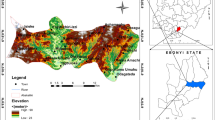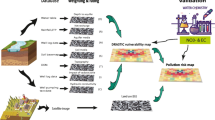Abstract
Groundwater vulnerability is a cornerstone in evaluating the risk of groundwater contamination and developing management options to preserve the quality of groundwater. Based on the professional model (DRASTIC model) and geographical information system (GIS) techniques, this paper carries out the shallow groundwater vulnerability assessment in the Zhangye Basin. The DRASTIC model uses seven environmental parameters (depth to water, net recharge, aquifer media, soil media, topography, impact of vadose zone, and hydraulic conductivity) to characterize the hydrogeological setting and evaluate aquifer vulnerability. According to the results of the shallow groundwater vulnerability assessment, the Zhangye Basin can be divided into three zones: low groundwater vulnerability risk zone (risk index <120); middle groundwater vulnerability risk zone (risk indexes 120–140) and high risk zone (risk index >140). Under the natural conditions, the middle and high groundwater vulnerability risk zones of the Zhangye Basin are mainly located in the groundwater recharge zones and the important cities. The high, middle and low groundwater vulnerability risk zones of the Zhangye Basin cover around 17, 21 and 62% of study area, respectively.











Similar content being viewed by others
References
Aller L, Bennet T, Leher JH, Petty RJ, Hackett G (1987) DRASTIC: a standardized system for evaluating ground water pollution potential using hydrogeological settings. EPA 600/2-87-035; 622
Chen MX (1997) The water resources related with Quaternary basin system in arid area of northwest China. Quat Sci Rev 16:97–104
Chen ZY, Nie ZL, Zhang GH, Wan L, Shen JM (2006) Environmental isotopic study on the recharge and residence time of groundwater in the Heihe River Basin, northwestern China. Hydrogeol J. doi:10.1007/s10040-006-0075-7
Ding H, Zhang J (2002) The problem of environmental caused by groundwater level continuous decline in the inland basins of arid area, Northwest China—an example in middle reaches of Heihe river basin. Hydrogeol Eng Geol 3:71–75 (in Chinese)
Fan X (1981) Transformation of groundwater and surface water and rational utilization of water resources in Hexi Corridor region. Hydrogeol Eng Geol 4:1–6 (in Chinese)
Gao Q (1991) Development and utilization of water resources in the Heihe River catchment. Gansu Science and Technology Press, Lanzhou, p 205 (in Chinese)
Li Z, Zhao C, Yang J (2004) The study of water resources system and macroscopic adjustment and control in the inland river basin, northwestern China. Gansu Institute of Geo-environmental Monitoring, Lanzhou, China, pp 19–64 (in Chinese)
Tang Q, Zhang J (2001) Water resources and eco-environment protection in the arid regions in northwest of China. Prog Geogr 20(3):227–233 (in Chinese)
US EPA (Environmental Protection Agency) (1985) DRASTIC: a standard system for evaluating groundwater potential using hydrogeological settings. Oklahoma WA/EPA Series, Ada, p 163
Wang G, Cheng G, Yang Z (1999) The utilization of water resources and its influence on eco-environment in the northwest arid area of China. J Nat Res 14(2):109–116 (in Chinese)
Wang X, Gao Q (2002) Sustainable development and management of water resources in the Hei River Basin of north-west China. Water Res Dev 18(2):335–352
Wen XH, Wu YQ, Wu J (2007) Hydrochemical characteristics of groundwater in the Zhangye Basin, Northwestern China. Environ Geol. doi:10.1007/s00254-007-1122-y
Zhang CY, Wang Z, Cheng XX (2004) Studies of nitrogen isotopes in sources of nitrate pollution in groundwater beneath the city of Zhangye. J Arid Land Res Environ 18(1):79–85 (in Chinese)
Acknowledgments
This work was supported by the Project of Chinese Academy of Science to young scientists in Western China (0628221001). National Science Foundation of China (40501012). The Knowledge Innovation Project of CAS (KZCX2-XB2-04-02). The authors wish to thank the anonymous reviewers for their reading of the manuscript, and for their suggestions and critical comments.
Author information
Authors and Affiliations
Corresponding author
Rights and permissions
About this article
Cite this article
Wen, X., Wu, J. & Si, J. A GIS-based DRASTIC model for assessing shallow groundwater vulnerability in the Zhangye Basin, northwestern China. Environ Geol 57, 1435–1442 (2009). https://doi.org/10.1007/s00254-008-1421-y
Received:
Accepted:
Published:
Issue Date:
DOI: https://doi.org/10.1007/s00254-008-1421-y




